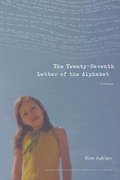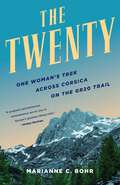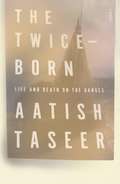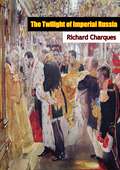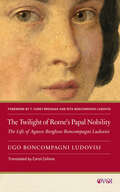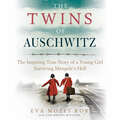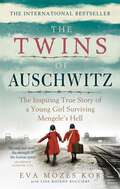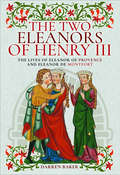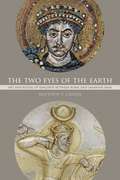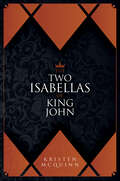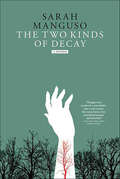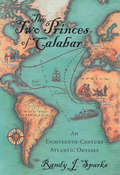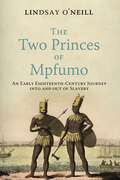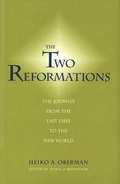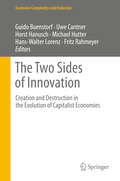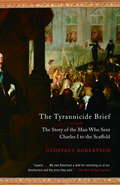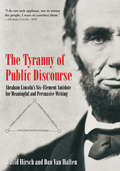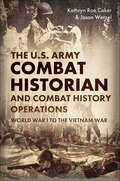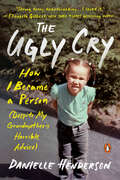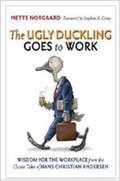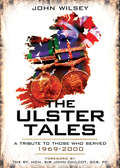- Table View
- List View
The Twenty-Seventh Letter of the Alphabet: A Memoir (American Lives)
by Kim AdrianClear-sighted, darkly comic, and tender, The Twenty-Seventh Letter of the Alphabet is about a daughter’s struggle to face the Medusa of generational trauma without turning to stone. Growing up in the New Jersey suburbs of the 1970s and 1980s in a family warped by mental illness, addiction, and violence, Kim Adrian spent her childhood ducking for cover from an alcoholic father prone to terrifying acts of rage and trudging through a fog of confusion with her mother, a suicidal incest survivor hooked on prescription drugs. Family memories were buried—even as they were formed—and truth was obscured by lies and fantasies. In The Twenty-Seventh Letter of the Alphabet Adrian tries to make peace with this troubled past by cataloguing memories, anecdotes, and bits of family lore in the form of a glossary. But within this strategic reckoning of the past, the unruly present carves an unpredictable path as Adrian’s aging mother plunges into ever-deeper realms of drug-fueled paranoia. Ultimately, the glossary’s imposed order serves less to organize emotional chaos than to expose difficult but necessary truths, such as the fact that some problems simply can’t be solved, and that loving someone doesn’t necessarily mean saving them.
The Twenty: One Woman's Trek Across Corsica on the GR20 Trail
by Marianne C. BohrGreat for fans of: Suzanne Roberts’s Almost Somewhere, Juliana Buhring’s This Road I Ride.Marianne Bohr and her husband, about to turn sixty, are restless for adventure. They decide on an extended, desolate trek across the French island of Corsica—the GR20, Europe’s toughest long-distance footpath—to challenge what it means to grow old. Part travelogue, part buddy story, part memoir, The Twenty is a journey across a rugged island of stunning beauty little known outside Europe. From a chubby, non-athletic child, Bohr grew into a fit, athletic person with an “I’ll show them” attitude. But hiking The Twenty forces her to transform a lifetime of hard-won achievements into acceptance of her body and its limitations. The difficult journey across a remote island provides the crucible for exploring what it means to be an aging woman in a youth-focused culture, a physically fit person whose limitations are getting the best of her, and the partner of a husband who is growing old with her. More than a hiking tale, The Twenty is a moving story infused with humor about hiking, aging, accepting life’s finite journey, and the intimacy of a long-term marriage—set against the breathtaking beauty of Corsica’s rugged countryside.
The Twice-Born: Life and Death on the Ganges
by Aatish TaseerIn The Twice-Born, Aatish Taseer embarks on a journey of self-discovery in an intoxicating, unsettling personal reckoning with modern India, where ancient customs collide with the contemporary politics of revivalism and revengeWhen Aatish Taseer first came to Benares, the spiritual capital of Hinduism, he was eighteen, the Westernized child of an Indian journalist and a Pakistani politician, raised among the intellectual and cultural elite of New Delhi. Nearly two decades later, Taseer leaves his life in Manhattan to go in search of the Brahmins, wanting to understand his own estrangement from India through their ties to tradition.Known as the twice-born—first into the flesh, and again when initiated into their vocation—the Brahmins are a caste devoted to sacred learning. But what Taseer finds in Benares, the holy city of death also known as Varanasi, is a window on an India as internally fractured as his own continent-bridging identity. At every turn, the seductive, homogenizing force of modernity collides with the insistent presence of the past. In a globalized world, to be modern is to renounce India—and yet the tide of nationalism is rising, heralded by cries of “Victory to Mother India!” and an outbreak of anti-Muslim violence.From the narrow streets of the temple town to a Modi rally in Delhi, among the blossoming cotton trees and the bathers and burning corpses of the Ganges, Taseer struggles to reconcile magic with reason, faith in tradition with hope for the future and the brutalities of the caste system, all the while challenging his own myths about himself, his past, and his countries old and new.
The Twilight of Imperial Russia (Galaxy Book; Gb419 Ser.)
by Richard CharquesThe fateful twenty-three years following the accession of the last of the Romanov Tsars formed the prologue to the Russian Revolution, and foreshadowed the motives and mental attitudes of Russian policy today. Richard Charques's detailed, vivid, and objective account of the reign of Nicholas II is based upon a wide study of Russian and other sources. It is given particular force and liveliness by the portrait gallery of the leading figures of the period; Nicholas II, the Tsaritsa Alexandra, Constantine Pobedonostsev, Sergius Witte, Lenin, Trotsky, Premier Stolypin, Miluikov, and Rasputin."Striking phrases, fine judgments, flashes of deep perception, flicker through these pages, illuminating the sad, sombre story, which Mr. Charques is not afraid to extend, by implication, into the present."--Observer (London)"Informative and well written, and the story of the last phase of the Romanovs is...movingly told."--New Statesman (London)"Mr. Charques writes with great lucidity and elegance; he has also unusual discernment, a healthy sense of historical reality, and a penetrating mind...Scrupulously fair."--Times Educational Supplement (London)"An uncommonly good book about the decline and fall of the Russian empire--lucid, incisive, well balanced, and extremely well written."--Chicago Sunday Tribune
The Twilight of Rome's Papal Nobility: The Life of Agnese Borghese Boncompagni Ludovisi (Other Voices of Italy)
by Ugo Boncompagni Ludovisi (1856–1935)Today, the Ludovisi district is one of Rome’s most luxurious neighborhoods, home to famous restaurants and some of the most expensive shops in the city. But it was once private property, part of an eighty-six-acre villa owned by the Boncompagni Ludovisis, an ancient noble family with close ties to the papacy. The story of how the palazzo fell out of the family's hands reveals the tremendous social upheavals that Italy underwent following its mid-nineteenth-century unification. First privately published in 1921, The Twilight of Rome's Papal Nobility provides an intimate look at a family who grew up accustomed to almost unimaginable wealth, power, and glamour. A descendant of two popes, Ugo Boncompagni Ludovisi recounts the life story of his mother Agnese, who was raised in a palace full of priceless artwork, including pieces by Caravaggio and Michelangelo. We get a window into Agnese's private life—her girlhood, marriage, and raising of several children—as her public life becomes increasingly tumultuous amid the family’s struggles to retain its property. A tender elegy to a bygone era, Boncompagni Ludovisi's story provides a unique perspective on Italian history and Rome’s urban redevelopment.
The Twins of Auschwitz: The inspiring true story of a young girl surviving Mengele's hell
by Lisa Rojany Buccieri Eva Mozes KorThe Nazis spared their lives because they were twins.In the summer of 1944, Eva Mozes Kor and her family arrived at Auschwitz.Within thirty minutes, they were separated. Her parents and two older sisters were taken to the gas chambers, while Eva and her twin, Miriam, were herded into the care of the man who became known as the Angel of Death: Dr. Josef Mengele. They were 10 years old.While twins at Auschwitz were granted the 'privileges' of keeping their own clothes and hair, they were also subjected to Mengele's sadistic medical experiments. They were forced to fight daily for their own survival and many died as a result of the experiments, or from the disease and hunger rife in the concentration camp.In a narrative told simply, with emotion and astonishing restraint, The Twins of Auschwitz shares the inspirational story of a child's endurance and survival in the face of truly extraordinary evil.Also included is an epilogue on Eva's incredible recovery and her remarkable decision to publicly forgive the Nazis. Through her museum and her lectures, she dedicated her life to giving testimony on the Holocaust, providing a message of hope for people who have suffered, and worked toward goals of forgiveness, peace, and the elimination of hatred and prejudice in the world.All images from the book are included in the accompanying pdf. This audiobook was recorded remotely in June 2020 during the Covid-19 pandemic. (P) 2020 Octopus Publishing Group
The Twins of Auschwitz: The inspiring true story of a young girl surviving Mengele's hell
by Lisa Rojany Buccieri Eva Mozes KorTHE SUNDAY TIMES BESTSELLER The Nazis spared their lives because they were twins.In the summer of 1944, Eva Mozes Kor and her family arrived at Auschwitz.Within thirty minutes, they were separated. Her parents and two older sisters were taken to the gas chambers, while Eva and her twin, Miriam, were herded into the care of the man who became known as the Angel of Death: Dr. Josef Mengele. They were 10 years old.While twins at Auschwitz were granted the 'privileges' of keeping their own clothes and hair, they were also subjected to Mengele's sadistic medical experiments. They were forced to fight daily for their own survival and many died as a result of the experiments, or from the disease and hunger rife in the concentration camp.In a narrative told simply, with emotion and astonishing restraint, The Twins of Auschwitz shares the inspirational story of a child's endurance and survival in the face of truly extraordinary evil.Also included is an epilogue on Eva's incredible recovery and her remarkable decision to publicly forgive the Nazis. Through her museum and her lectures, she dedicated her life to giving testimony on the Holocaust, providing a message of hope for people who have suffered, and worked toward goals of forgiveness, peace, and the elimination of hatred and prejudice in the world.
The Twins of Auschwitz: The inspiring true story of a young girl surviving Mengele's hell
by Lisa Rojany Buccieri Eva Mozes KorTHE SUNDAY TIMES BESTSELLER The Nazis spared their lives because they were twins.In the summer of 1944, Eva Mozes Kor and her family arrived at Auschwitz.Within thirty minutes, they were separated. Her parents and two older sisters were taken to the gas chambers, while Eva and her twin, Miriam, were herded into the care of the man who became known as the Angel of Death: Dr. Josef Mengele. They were 10 years old.While twins at Auschwitz were granted the 'privileges' of keeping their own clothes and hair, they were also subjected to Mengele's sadistic medical experiments. They were forced to fight daily for their own survival and many died as a result of the experiments, or from the disease and hunger rife in the concentration camp.In a narrative told simply, with emotion and astonishing restraint, The Twins of Auschwitz shares the inspirational story of a child's endurance and survival in the face of truly extraordinary evil.Also included is an epilogue on Eva's incredible recovery and her remarkable decision to publicly forgive the Nazis. Through her museum and her lectures, she dedicated her life to giving testimony on the Holocaust, providing a message of hope for people who have suffered, and worked toward goals of forgiveness, peace, and the elimination of hatred and prejudice in the world.
The Two Eleanors of Henry III: The Lives of Eleanor of Provence and Eleanor de Montfort
by Darren BakerThis account of two strong medieval women and their relationship &“thoroughly engrosses you in a story hundreds of years past&”(Seattle Book Review). Born in 1223, Eleanor of Provence has come to England at the age of twelve to marry the king, Henry III. He&’s sixteen years older, but was a boy when he ascended the throne. He&’s a kind, sensitive sort whose only personal attachments to women so far have been to his three sisters. The youngest of those sisters is called Eleanor too. She was only nine when, for political reasons, her first marriage took place, but she&’s already a chaste twenty-year-old widow when the new queen arrives in 1236. Soon, this Eleanor will marry the rising star of her brother&’s court, a French parvenu named Simon de Montfort, thus wedding the fates of these four people together in an England about to undergo some of the most profound changes in its history. The Two Eleanors of Henry III is a tale that spans decades, with loyalty to family and principles at stake, in a land where foreigners are subject to intense scrutiny and jealousy. The relationship between these two sisters-in-law, close but ultimately doomed, reflects not just the turbulence and tragedy of their times, but also the brilliance and splendor.
The Two Eleanors of Henry III: The Lives of Eleanor of Provence and Eleanor de Montfort
by Darren BakerThis account of two strong medieval women and their relationship &“thoroughly engrosses you in a story hundreds of years past&”(Seattle Book Review). Born in 1223, Eleanor of Provence has come to England at the age of twelve to marry the king, Henry III. He&’s sixteen years older, but was a boy when he ascended the throne. He&’s a kind, sensitive sort whose only personal attachments to women so far have been to his three sisters. The youngest of those sisters is called Eleanor too. She was only nine when, for political reasons, her first marriage took place, but she&’s already a chaste twenty-year-old widow when the new queen arrives in 1236. Soon, this Eleanor will marry the rising star of her brother&’s court, a French parvenu named Simon de Montfort, thus wedding the fates of these four people together in an England about to undergo some of the most profound changes in its history. The Two Eleanors of Henry III is a tale that spans decades, with loyalty to family and principles at stake, in a land where foreigners are subject to intense scrutiny and jealousy. The relationship between these two sisters-in-law, close but ultimately doomed, reflects not just the turbulence and tragedy of their times, but also the brilliance and splendor.
The Two Eyes of the Earth: Art and Ritual of Kingship between Rome and Sasanian Iran
by Matthew P. CanepaThis pioneering study examines a pivotal period in the history of Europe and the Near East and investigates the shared ideal of sacred kingship that emerged in the late Roman and Persian empires and explores the artistic, ritual, and ideological interactions between Rome and the Iranian world under the Sasanian dynasty.
The Two Isabellas of King John
by Kristen McQuinnKing John of England was married to two women: Isabella of Gloucester and Isabelle of Angoulême. The two women were central to shaping John and his reign, each in her own way molding the king and each other over their lives. Little is known about Isabella of Gloucester and she has largely become an historical footnote; Isabelle of Angoulême has a reputation as a witch and poisoner. However, both were products of their time, victims and pawns of the powerful men whose voices overwrote the experiences of women. By examining these two very different women through a modern feminist lens, The Two Isabellas offers new insight into one of England’s lesser-known queens and a different interpretation of one of its least popular kings. In The Two Isabellas of King John, Kristen McQuinn offers new and intriguing insights into two of England’s important yet little understood queen-consorts, the wives of King John. Taking a feminist light, McQuinn brightly shines it on both England’s least well-known consort, Isabella of Gloucester, his first wife, and one of its least popular, Isabelle of Angoulême, his child bride.
The Two Kinds of Decay: A Memoir
by Sarah MangusoA poet and author recounts her nine-year struggle with a rare autoimmune disease in this spare and unsparing memoir of illness and recovery.At twenty-one, just as she was starting to comprehend the puzzles of adulthood, Sarah Manguso was faced with another: a wildly unpredictable disease that appeared suddenly and tore through her twenties, paralyzing her for weeks at a time, programming her first to expect nothing from life and then, furiously, to expect everything. In this captivating story, Manguso recalls her struggle: arduous blood cleansings, collapsed veins, multiple chest catheters, the deaths of friends and strangers, addiction, depression, and, worst of all for a writer, the trite metaphors that accompany prolonged illness. A book of tremendous grace and self-awareness, The Two Kinds of Decay transcends the very notion of what an illness story can and should be.Praise for The Two Kinds of DecayA New York Times Book Review Editors’ ChoiceBest Book of the Year, San Francisco Chronicle and Time Out Chicago“Moving . . . a fiercely truthful memoir.” —The Boston Globe“Hers is not a day-by-day description of this grueling time, but an impressionistic text filled with bright, poetic flashes. . . . Many sick people learn to live in the moment, but the power of Manguso’s writing makes that truism revelatory.” —The Washington Post Book World“Sarah Manguso has miraculously elevated the act of memory. She has found honesty, fear, longing and beauty in every moment of her young life, giving this book an intensity found nowhere else. You put it down panting with wonder and grief, but never with pity. A breakthrough in the memoir, and in writing.” —Andrew Sean Greer
The Two Loves of Will Shakespeare
by Laurie LawlorYoung William Shakespeare should be taking his glove-making apprenticeship much more seriously. However, carousing with his friends, carrying on with women, and sneaking off to see plays are all higher priorities for him. All this changes when Will's best friend, Richard, asks him to write and deliver sonnets to a young woman, pretending the love poems are from Richard. Once Will lays eyes on the exquisitely beautiful Anne Whateley, he is deeply in love. He wants more than anything to make himself into a man worthy of such a young woman. But entanglements with a certain Anne Hathaway, the discovery of an old prank, and his distracted nature all complicate matters for the future Bard of Avon. In this highly entertaining historical novel Laurie Lawlor imagines how there came to be two different marriage license applications taken out on consecutive dates in November of 1582 between eighteen-year-old William Shakespeare and two different women both named Anne.
The Two Princes of Calabar: An Eighteenth-Century Atlantic Odyssey
by Randy J. SparksThis is a rare glimpse into the 18th century Atlantic World and slave trade from an African perspective. It brings us into the trading communities along the coast of Africa and follows the regular movement of goods, people and ideas across and around the Atlantic.
The Two Princes of Mpfumo: An Early Eighteenth-Century Journey into and out of Slavery (The Early Modern Americas)
by Lindsay O'NeillA fascinating account of two eighteenth-century princes from East Africa, their travels, and their encounters with the British Empire and slaveryIn 1716 two princes from Mpfumo—what is today Maputo, the capital of Mozambique—boarded a ship licensed by the East India Company bound for England. Instead, their perfidious captain sold them into slavery in Jamaica. After two years of pleading their case, the princes—known in the historical record as Prince James and Prince John—convinced a lawyer to purchase them, free them, and travel with them to London. The lawyer perished when a hurricane wrecked their ship, but the princes survived and arrived in England in 1720. Even though the East India Company had initially thought that the princes might assist in their aspirations to develop a trade for gold in East Africa and for enslaved labor in Madagascar, its interest waned. The princes would need to look elsewhere to return home. It was at this point that members of the Royal African Company and the Society for Promoting Christian Knowledge took up their cause, in the hope that profit and perhaps Christian souls would follow. John would make it home, but tragically, James would end his own life just before the ship sailed for Africa.In The Two Princes of Mpfumo, Lindsay O’Neill brings to life individuals caught up in the eighteenth-century slave trade. O’Neill also shows how the princes’ experiences reflect the fragmented, chaotic, and often deadly realities of the early British empire. A fascinating and deeply researched historical narrative, The Two Princes of Mpfumo blurs the boundaries between the Atlantic and Indian ocean worlds; reveals the intertwined networks, powerful individuals, and unstable knowledge that guided British attempts at imperial expansion; and illuminates the power of African polities, which decided who lived and who died on their coasts.
The Two Reformations: The Journey from the Last Days to the New World
by Heiko A. Oberman Donald WeinsteinIn this last collection of his vital, controversial, and accessible writings, Oberman seeks to liberate and broaden our understanding of the European Reformation, from its origins in medieval philosophy and theology through the Puritan settlers who brought Calvin's vision to the New World. Ranging over many topics, he finds fascinating connections between aspects of the Reformation and twentieth-century history and thought--most notably the connection to Nazism and the Holocaust.
The Two Sides of Innovation
by Uwe Cantner Guido Buenstorf Horst Hanusch Michael Hutter Hans-Walter Lorenz Fritz RahmeyerThis volume is devoted to innovation with a special focus on its two sides, namely creation and destruction, and on its role in the evolution of capitalist economies. The first part of the book looks at innovation and its effects on economic performance, addressing issues of motives, behavioral rules under uncertainty, actor properties, and technology characteristics. The second part concentrates on potential consequences of innovative activities, in particular structural change, the "innovation-mediated" effect of skill-oriented policies on regional performance, the destructive effects of innovation activities, and the question whether novelty is always good. The role of innovation in the evolution of capitalism itself is discussed in the third part.
The Two-In-One: Walking With Smokie, Walking With Blindness
by Rod MichalkoWhen Rod Michalko's sight finally became so limited that he no longer felt safe on busy city streets, he began to search for a guide.
The Tyrannicide Brief: The Story of the Man Who Sent Charles I to the Scaffold
by Geoffrey RobertsonCharles I waged civil wars that cost one in ten Englishmen their lives. But in 1649 Parliament was hard put to find a lawyer with the skill and daring to prosecute a king who claimed to be above the law. In the end, they chose the radical lawyer John Cooke, whose Puritan conscience, political vision, and love of civil liberties gave him the courage to bring the king to trial. As a result, Charles I was beheaded, but eleven years later Cooke himself was arrested, tried, and executed at the hands of Charles II.Geoffrey Robertson, a renowned human rights lawyer, provides a vivid new reading of the tumultuous Civil War years, exposing long-hidden truths: that the king was guilty, that his execution was necessary to establish the sovereignty of Parliament, that the regicide trials were rigged and their victims should be seen as national heroes. Cooke’s trial of Charles I, the first trial of a head of state for waging war on his own people, became a forerunner of the trials of Augusto Pinochet, Slobodan Milosevic, and Saddam Hussein. The Tyrannicide Brief is a superb work of history that casts a revelatory light on some of the most important issues of our time.
The Tyranny of Public Discourse: Abraham Lincoln’s Six-Element Antidote for Meaningful and Persuasive Writing
by David Hirsch Dan Van HaftenAre you satisfied with the current state of public discourse? The almost unanimous response from people across the nation is a loud and emphatic “No!” The reply is always the same regardless of politics. Today’s public discourse typically starts with a “conclusion” and goes downhill from there. If there are talking heads, argument begins instantly and typically runs in circles. This is a dangerous path for a society that depends upon civility and virtue to survive. The Tyranny of Public Discourse: Abraham Lincoln’s Six-Element Antidote for Meaningful and Persuasive Writing by scholars David Hirsch and Dan Van Haften addresses what is one of the most important issues of our time. This book can teach anyone how to use logic and reason to create persuasive writing. A byproduct of this is the civility that will ensue with an elevated public discourse. The Tyranny of Public Discourse establishes the six elements of a proposition as a verbal form of the scientific method—something Abraham Lincoln knew and used routinely. His logic and reason is so well known that it is quoted today more than 150 years after his death. Learning the six elements and how to use them to discuss any topic at any time is not only fascinating, but fairly easy to understand and implement. This book sets it all out, step-by-step and color coded, from beginning to end. The Tyranny of Public Discourse: Abraham Lincoln’s Six-Element Antidote for Meaningful and Persuasive Writing, complete with 21 diagrams on how to structure your logic, is the book you have been waiting for. The time is short, and the hour is now.
The U.S. Army Combat Historian and Combat History Operations: World War I to the Vietnam War
by Jason Wetzel Kathryn Roe Coker"How is history useful for an operational commander or to soldiers in general? What role does history have for doctrine and training to the U.S. Army as an institution? These are questions this book answers as the authors narrate the development combat historian and the evolving role of combat historians as they develop history into a useful tool for informing training, operations, and doctrine development."—New York Journal of Books In World War I, Major General Pershing proposed the idea of establishing a historical office within the AEF headquarters. The War Department reorganized the General Staff to include a Historical Branch. Evidence shows that soldiers acting as historians went "down range," albeit not into combat. By World War II, the situation had changed—whether S.L.A. Marshall's popping out of a billet in Sibret as a shells exploded on the road; Forrest Pogue's typing "on a little camp desk under an apple tree;" Chester Starr's terrain reconnaissance in the Mediterranean theater, or Ken Hechler's command of a four-man historical team interviewing soldiers at the Remagen Bridge and searching through secret documents—the World War II combat historians were there behind and on the front lines with a notebook in one hand and their carbine in the other hand, ever ready to collect battlefield information. Eight historical service detachments were deployed to Korea. The youngest commander, 1st Lieutenant Bevin Alexander, noted "We were on the front lines the whole time . . . We would interview the people afterwards and create a battle study…." After the Korean War, the duties of the combat historian further evolved as what became the Center of Military History published doctrine about military history detachments (MHDs). As America’s immersion in Vietnam escalated, there was concern regarding historical coverage. Chief of Military History Brigadier General Hal Pattison established a network of historical teams to collect information on the U.S Army in the war. A major development in the history program and in deploying MHDs came with the establishment of Headquarters, U.S. Army Vietnam (USARV) under General William C. Westmoreland’s command. In 1965, the history office was organized at Headquarters, U.S. Army Vietnam (USARV). MHDs were deployed across Vietnam, conducting combat after action interviews, and collecting documents. This study focuses on U.S. Army historical programs during combat operations from World War I to the Vietnam War with particular attention on the combat historians, those individuals deployed to a theater of war with the mission of documenting the actions of that theater for current and future historical use.
The Ugly Cry: A Memoir
by Danielle Henderson“If you fight that motherf**ker and you don’t win, you’re going to come home and fight me.” Not the advice you’d normally expect from your grandmother—but Danielle Henderson would be the first to tell you her childhood was anything but conventional. Abandoned at ten years old by a mother who chose her drug-addicted, abusive boyfriend, Danielle was raised by grandparents who thought their child-rearing days had ended in the 1960s. She grew up Black, weird, and overwhelmingly uncool in a mostly white neighborhood in upstate New York, which created its own identity crises. Under the eye-rolling, foul-mouthed, loving tutelage of her uncompromising grandmother—and the horror movies she obsessively watched—Danielle grew into a tall, awkward, Sassy-loving teenager who wore black eyeliner as lipstick and was struggling with the aftermath of her mother’s choices. But she also learned that she had the strength and smarts to save herself, her grandmother gifting her a faith in her own capabilities that the world would not have most Black girls possess. With humor, wit, and deep insight, Danielle shares how she grew up and grew wise—and the lessons she’s carried from those days to these. In the process, she upends our conventional understanding of family and redefines its boundaries to include the millions of people who share her story.
The Ugly Duckling Goes to Work: Wisdom for the Workplace from the Classic Tales of Hans Christian Andersen
by Mette NorgaardFrom the book: Are outer demands for more success, more money, and more prestige overwhelming your inner longings? Is your work no longer energizing you? Years of frenetic activity and blind ambition have robbed many people of the joy and fulfillment they once found in their work. The successes they crave and failures they fear have come to define them. But there is hope, and it can be found in a few simple yet timeless stories. The great Danish writer Hans Christian Andersen succinctly illuminated life's challenges in his treasured fairy tales for children and adults. And now, in celebration of H.C. Andersen's 200th birthday, the powerful lessons of these classic folk tales have been ingeniously applied to the complexities of the modern workplace. The Ugly Duckling Goes to Work probes H. C. Andersen's sharp and witty stories for lessons that will inspire you to bring more meaning, more energy, and more joy to your work -- to create a meaningful work life.
The Ulster Tales: A Tribute to Those Who Served, 1969–2000
by John Wilsey&“Presents an insider&’s account of the experiences of ten Britons who were prominently involved in the Northern Ireland &‘troubles&’ between 1969 and 2000.&” —Perspectives on Terrorism The Ulster Tales captures the lives and experiences of ten individuals who were caught up in the Troubles. Each has a very distinct story to tell according to their role and position. Arranged roughly in chronological order, the book covers the media, military, intelligence, police, business, politics, and civil service. The first &“tale&” is that of Simon Hoggart, the journalist who reported for the Guardian newspaper in Belfast and London from the start. The military angle is covered by the GOC at a critical moment (General Sir Richard Lawson), a Private in The Green Howards from Barnsley, and a widow. A member of MI5 and a key Source Handler represent the Intelligence effort. The politician is Tom King who was Secretary of State at the time of the Anglo-Irish Agreement and narrowly avoided assassination, and we hear of the role of a top civil servant, Sir John Blelloch. &“The Policeman&’s Tale&” is that of a young Met officer who transferred to the RUC. The book is both a tribute to the many who dedicated their lives to the fight against terrorism and an original and interesting way of promoting a better understanding of the complex Northern Ireland situation.&“Sheds new light on a long and bloody military campaign. Each is moving and revealing, in varying degree, but all are uniformly absorbing.&” —The Times &“Veterans of the conflict will probably find the varied perspectives of policemen, businessmen, and civil servants a stimulating contrast to their own experience.&” —Terrorism and Political Violence
